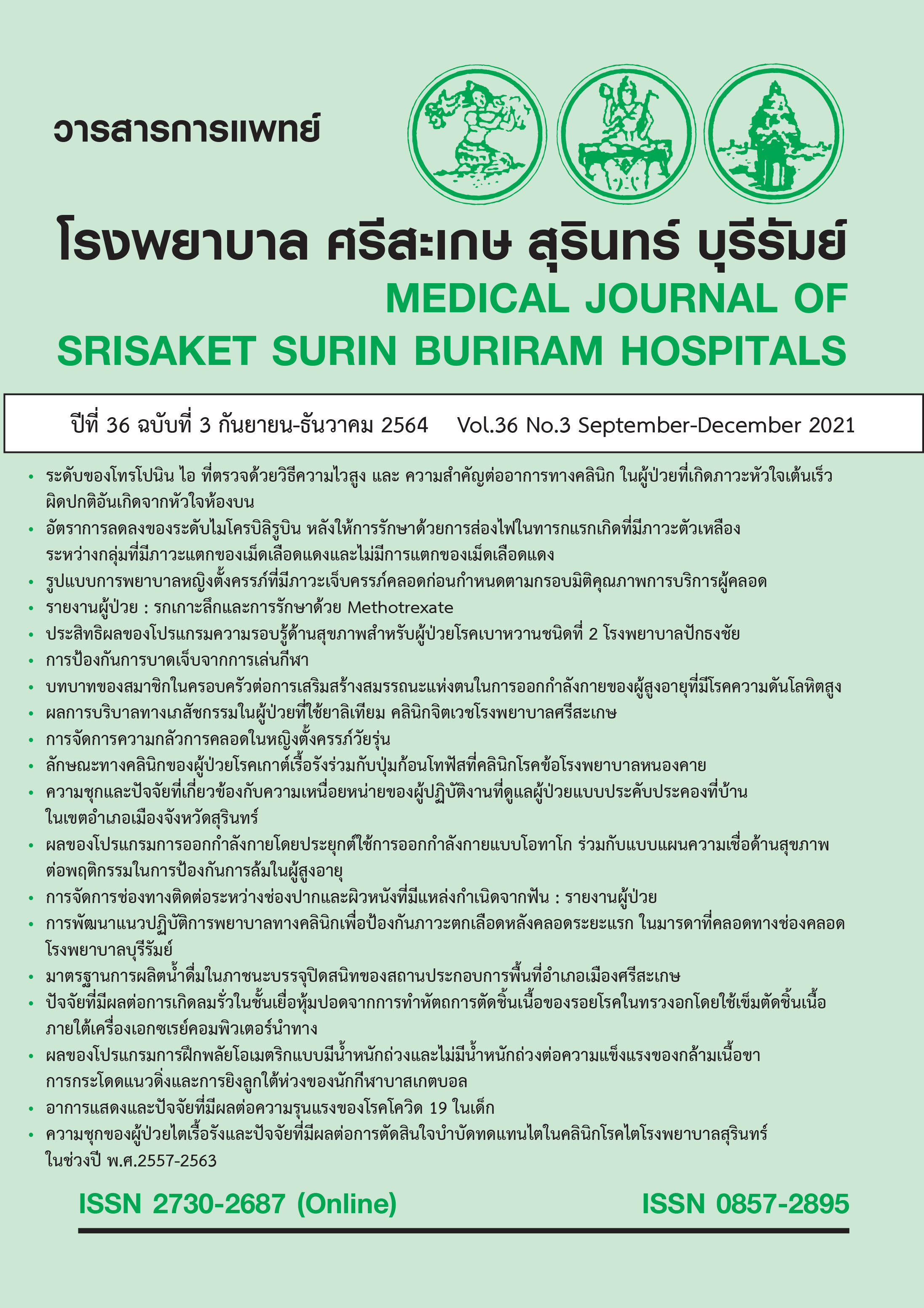ปัจจัยที่มีผลต่อการเกิดลมรั่วในชั้นเยื่อหุ้มปอดจากการทำหัตถการตัดชิ้นเนื้อของรอยโรคในทรวงอกโดยใช้เข็มตัดชิ้นเนื้อภายใต้เครื่องเอกซเรย์คอมพิวเตอร์นำทาง
Main Article Content
บทคัดย่อ
หลักการและเหตุผล: การทำหัตถการตัดชิ้นเนื้อของรอยโรคในทรวงอกโดยใช้เข็มตัดชิ้นเนื้อภายใต้เครื่องเอกซเรย์คอมพิวเตอร์นำทาง เป็นการทำหัตถการที่มีความแม่นยำ รุกล้ำร่างกายผู้ป่วยน้อยกว่าการผ่าตัดช่องอก และเหมาะสำหรับรอยโรคที่อยู่ริมปอด ภาวะแทรกซ้อนที่พบบ่อยจากการทำหัตถการคือลมรั่วในชั้นเยื่อหุ้มปอด
วัตถุประสงค์: เพื่อศึกษาปัจจัยที่มีผลต่อการเกิดลมรั่วในชั้นเยื่อหุ้มปอดจากการทำหัตถการตัดชิ้นเนื้อของรอยโรคที่ปอดโดยใช้เข็มตัดชิ้นเนื้อภายใต้เครื่องเอกซเรย์คอมพิวเตอร์นำทาง
วิธีการศึกษา: การศึกษาเชิงสมุฏฐาน ศึกษาผู้ป่วยที่มาทำการตัดชิ้นเนื้อที่ปอดโดยใช้เข็มตัดชิ้นเนื้อภายใต้เครื่องเอกซเรย์คอมพิวเตอร์นำทาง ที่โรงพยาบาลมหาราชนครราชสีมา ระหว่างเดือน ตุลาคม 2555 ถึง กันยายน 2563โดยรวบรวมข้อมูลทั่วไป ข้อมูลทางคลินิก ข้อมูลจากภาพเอกซเรย์คอมพิวเตอร์ และวิเคราะห์ข้อมูลด้วยสถิติเชิงพรรณนาและ ความเสี่ยงสัมพัทธ์
ผลการศึกษา: ผู้ป่วยที่ทำหัตถการตัดชิ้นเนื้อของรอยโรคที่ปอดโดยใช้เข็มตัดชิ้นเนื้อภายใต้เครื่องเอกซเรย์คอมพิวเตอร์นำทางจำนวน 270 ราย เป็นเพศชายร้อยละ 59.3 อายุมากกว่า65 ปีร้อยละ 48.6 มีโรคร่วมของปอดร้อยละ 11.9 ตำแหน่งรอยโรคร้อยละ 33.7อยู่ที่ชายปอดเข็มตัดชิ้นเนื้อผ่านเยื่อหุ้มปอด 1ชั้นร้อยละ 96.3 เกิดลมรั่วภายในชั้นเยื่อหุ้มปอดร้อยละ 14.8 ปัจจัยที่มีผลต่อการเกิดลมรั่วภายในชั้นเยื่อหุ้มปอดได้แก่ ตำแหน่งรอยโรคที่ชายปอด และเข็มผ่านชั้นเยื่อหุ้มปอดมากกว่า 1 ชั้น โดยตำแหน่งรอยโรคที่ชายปอดมีโอกาสเกิดลมรั่วภายในชั้นเยื่อหุ้มปอด มากกว่าตำแหน่งปอดด้านบน 3.16 เท่า และการตัดชิ้นเนื้อก้อนโดยที่เข็มผ่านชั้นเยื่อหุ้มปอดมากกว่า 1 ชั้น มีโอกาสเกิดลมรั่วมากกว่าการที่เข็มผ่านชั้นเยื่อหุ้มปอด 1 ชั้น เท่ากับ 13.72 เท่า
สรุป: การเกิดลมรั่วในชั้นเยื่อหุ้มปอด จากการตัดชิ้นเนื้อของรอยโรคที่ปอดโดยใช้เข็มตัดชิ้นเนื้อภายใต้เครื่องเอกซเรย์คอมพิวเตอร์นำทางเป็นภาวะที่เกิดได้บ่อย การประเมินความเสี่ยงของการตัดชิ้นเนื้อมีความสำคัญเพื่อให้คำแนะนำแก่ผู้ป่วย และการเตรียมความพร้อมของผู้ทำหัตถการ
คำสำคัญ: การตัดชิ้นเนื้อ, เอกซเรย์คอมพิวเตอร์, ลมรั่วในชั้นเยื่อหุ้มปอด
Article Details

อนุญาตภายใต้เงื่อนไข Creative Commons Attribution-NonCommercial-NoDerivatives 4.0 International License.
เอกสารอ้างอิง
Schreiber G, McCrory DC. Performance characteristics of different modalities for diagnosis of suspected lung cancer: summary of published evidence. Chest 2003;123(1 Suppl):115S-128S. doi: 10.1378/chest.123.1_suppl.115s.
Manhire A, Charig M, Clelland C, Gleeson F, Miller R, Moss H, et al. Guidelines for radiologically guided lung biopsy. Thorax 2003;58(11):920-36. doi: 10.1136/thorax.58.11.920.
Laurent F, Latrabe V, Vergier B, Montaudon M, Vernejoux JM, Dubrez J. CT-guided transthoracic needle biopsy of pulmonary nodules smaller than 20 mm: results with an automated 20-gauge coaxial cutting needle. Clin Radiol 2000;55(4):281-7. doi: 10.1053/crad.1999.0368.
Loubeyre P, Copercini M, Dietrich PY. Percutaneous CT-guided multisampling core needle biopsy of thoracic lesions. AJR Am J Roentgenol 2005;185(5):1294-8. doi: 10.2214/AJR.04.1344.
Chakrabarti B, Earis JE, Pandey R, Jones Y, Slaven K, Amin S, et al. Risk assessment of pneumothorax and pulmonary haemorrhage complicating percutaneous co-axial cutting needle lung biopsy. Respir Med 2009;103(3):449-55. doi: 10.1016/j.rmed.2008.09.010.
Boskovic T, Stanic J, Pena-Karan S, Zarogoulidis P, Drevelegas K, Katsikogiannis N, et al. Pneumothorax after transthoracic needle biopsy of lung lesions under CT guidance. J Thorac Dis 2014;6 Suppl 1(Suppl 1):S99-S107. doi: 10.3978/j.issn.2072-1439.2013.12.08.
Anzidei M, Sacconi B, Fraioli F, Saba L, Lucatelli P, Napoli A, et al. Development of a prediction model and risk score for procedure-related complications in patients undergoing percutaneous computed tomography-guided lung biopsy. Eur J Cardiothorac Surg 2015;48(1):e1-6. doi: 10.1093/ejcts/ezv172.
Hiraki T, Mimura H, Gobara H, Shibamoto K, Inoue D, Matsui Y, et al. Incidence of and risk factors for pneumothorax and chest tube placement after CT fluoroscopy-guided percutaneous lung biopsy: retrospective analysis of the procedures conducted over a 9-year period. AJR Am J Roentgenol 2010;194(3):809-14. doi: 10.2214/AJR.09.3224.
Heyer CM, Reichelt S, Peters SA, Walther JW, Müller KM, Nicolas V. Computed tomography-navigated transthoracic core biopsy of pulmonary lesions: which factors affect diagnostic yield and complication rates?. Acad Radiol 2008;15(8):1017-26. doi: 10.1016/j.acra.2008.02.018.
Yildirim E, Kirbas I, Harman A, Ozyer U, Tore HG, Aytekin C, et al. CT-guided cutting needle lung biopsy using modified coaxial technique: factors effecting risk of complications. Eur J R 2009;70(1):57-60. doi: 10.1016/j.ejrad.2008.01.006.
Yeow KM, Su IH, Pan KT, Tsay PK, Lui KW, Cheung YC, et al. Risk factors of pneumothorax and bleeding: multivariate analysis of 660 CT-guided coaxial cutting needle lung biopsies. Chest 2004;126(3):748-54. doi: 10.1378/chest.126.3.748.
Bai C, Choi CM, Chu CM, Anantham D, Chung-Man Ho J, Khan AZ, et al. Evaluation of Pulmonary Nodules: Clinical Practice Consensus Guidelines for Asia. Chest 2016;150(4):877-93. doi: 10.1016/j.chest.2016.02.650.
Lee SM, Park CM, Lee KH, Bahn YE, Kim JI, Goo JM. C-arm cone-beam CT-guided percutaneous transthoracic needle biopsy of lung nodules: clinical experience in 1108 patients. Radiology 2014;271(1):291-300. doi: 10.1148/radiol.13131265.
Yoon SH, Park CM, Lee KH, Lim KY, Suh YJ, Im DJ, et al. Analysis of Complications of Percutaneous Transthoracic Needle Biopsy Using CT-Guidance Modalities In a Multicenter Cohort of 10568 Biopsies. Korean J Radiol 2019;20(2):323-31. doi: 10.3348/kjr.2018.0064.
Cox JE, Chiles C, McManus CM, Aquino SL, Choplin RH. Transthoracic needle aspiration biopsy: variables that affect risk of pneumothorax. Radiology 1999;212(1):165-8. doi: 10.1148/radiology.212.1.r99jl33165.
Madani A, Zanen J, de Maertelaer V, Gevenois PA. Pulmonary emphysema: objective quantification at multi-detector row CT--comparison with macroscopic and microscopic morphometry Radiology 2006;238(3):1036-43. doi: 10.1148/radiol.2382042196


